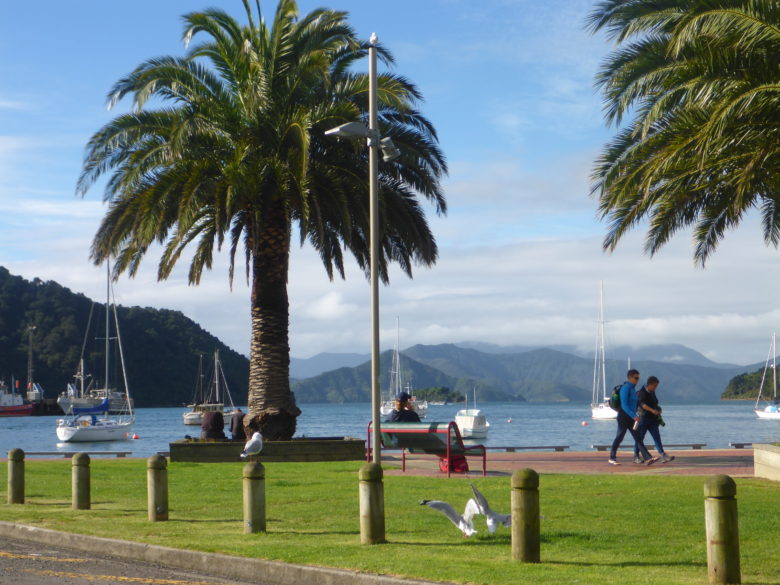Our Last Day in Blenheim
Sir Peter Jackson and his team capture WW1 and WW2 themes in the Knights of the Sky and Dangerous Skies exhibitions at the Omaka Heritage Centre, Blenheim.
It rained nearly all day and over much of New Zealand that day, which was to prove significant for us as I will explain later.
In two aircraft hangers at the small Blenheim Airport Sir Peter Jackson has applied his penetrating intelligence to the creation of numerous cameo scenes from both World Wars. Amidst original and replica planes on display, full scale personnel live their lives in camp dormitories, on the field, in the air, beside crashed planes and in the workshops. We stand silently by like Alice in Wonderland and witness tyre tracks in the mud made by a nurse arriving at a crash site, the freezing snow beneath a plane stuck in a tree where the lucky pilot is being questioned by his captors. A crew discussing their flight with the mechanic before take-off and men in the workshop creating new aircraft from wood.
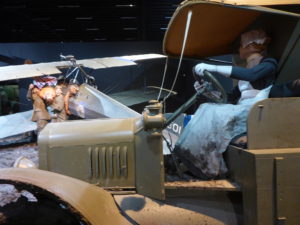
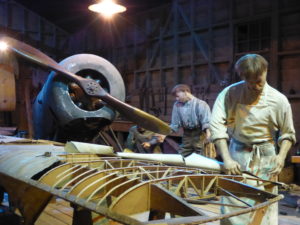
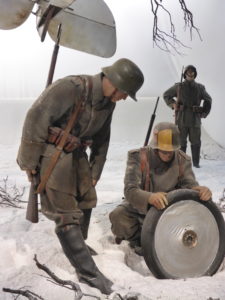
The ‘people’ are so real that standing by them I waited for them to take their next breath. The Red Baron’s life is recorded without bias down to his iconic furry boots, he was not one to suffer cold feet after all was he. After he crashed and lay dying from a gunshot wound beside his plane British troops are busy stealing mementoes from the site, a portrayal that has caused some controversy since the exhibition opened. But alls fair, or unfair, in love and war.
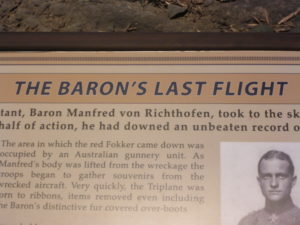
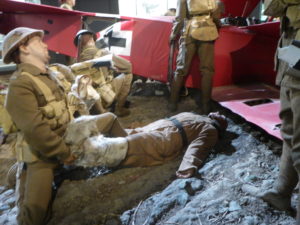
The story of the fearless female Russian aviatrix Lilya Litvyak is presented affectionately with a model of her gazing towards her beloved skies, her chest a gallery of hard earned medals. She represents a country that suffered losses greater in number by far than any other in modern warfare, an estimated 14 million people.
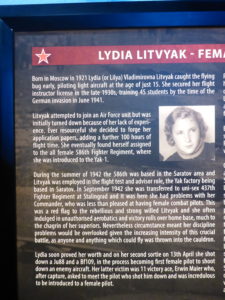
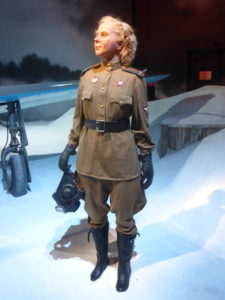
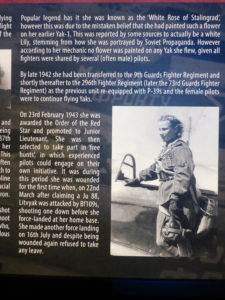
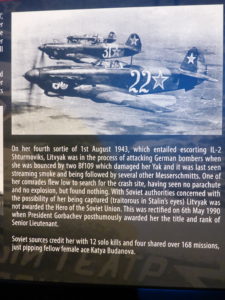
We watched a digitally restored film of a rear gunner rummaging around in the floor of his plane and finding what he is looking for. He then holds the bomb by its tail and drops it like a fish overboard, a strangely funny scene. We sat in the ruins of a high building in Stalingrad with the cacophony of an air bombardment going on around us and sense the claustrophobic terror of being trapped.
The walls of the exhibition halls are black and spotlights create a light appropriate to the era and the darkness of war and also of course the danger of the night skies. A truly remarkable exhibition, and I wonder if it is portable and maybe one day will do the rounds of European exhibition halls. I hope so.
It felt like a come down, walking in the rain back to the car. We made our way into Blenheim to search for supper. The streets were empty on this wet Sunday but we found a nice pizza restaurant and cheered ourselves with a bottle of Marlborough Sauvignon Blanc. A queen of wines with its sharp fruity flavour to enhance any pizza.
That night it rained heavily back on our little tent pitched next to the fine 19th century villa with its kaori ceilings and doors. The house was built by a doctor and the present owners have plans to restore it to its original glory. In the meantime campers enjoy the ambience of the fine trees he planted and the pretty stream, Spring Creek after which the village is called, running around the perimeter of the grounds.
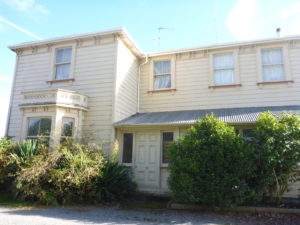
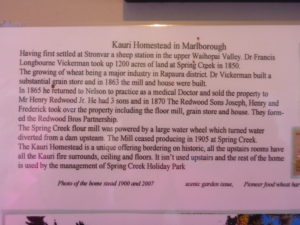
The next morning promised a better day so we drove to Picton to explore the town from which our ferry would take us back to the North Island the next day and to visit the Edwin Fox, the oldest surviving ship that brought 751 immigrants to NZ over four voyages and made one voyage from London to Australia.
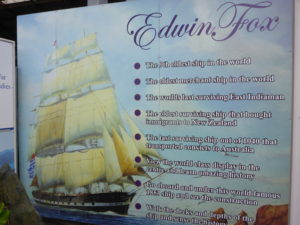
Built using Burmese Teak no expense was spared in either her construction or her maintenance over the years of her sailing career. Which is partly why she still exists today. On every third voyage her bottom was re-coppered at considerable expense. She reminded me of Henry V111’s flagship the Mary Rose, raised and preserved in Portsmouth Naval Dockyard. On both one can now walk around and get a feel of life onboard back in their working time.
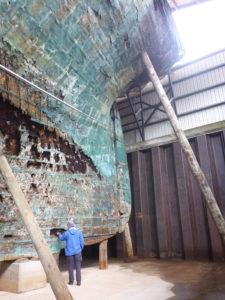
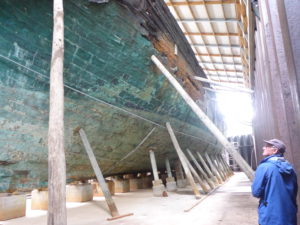
The Edwin Fox did 34 part world voyages before her roles changed and at one point she was a refridgeration ship storing up to 1400 lamb carcasses at a time. Now she is permanently dry docked in the middle of the shipping activity in Picton, an appropriate retirement for a fine vessel.
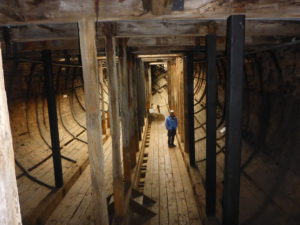
We were sitting on the pretty waterfront in Vicky just taking in the view, when Rob’s phone started ringing. Rob put it on to speaker so I could hear the conversation too. The caller was Jeannie from Meridian Passage whom we had come across before in brief greetings as we came alongside the pontoon near them to go ashore. Her tone was distracted and very concerned. “Rob I am looking across at Zoonie and she appears to be very low in the water. Merv and I are making our way to her, here he is in the dinghy, I’ll call you back once we are on board.”

A few moments later “We’ve broken in and are bailing her with buckets, the water is coming in rapidly where are the skin fittings?” We explained they were all closed except for the bilge pump outlet and cockpit drains. Over the next two hours the drama unfolded with frequent calls from Jeannie to update and ask us for more details. Zoonie was bows down and sinking fast, water pouring in from two sources including over the sink which was now near the level of the rising water.
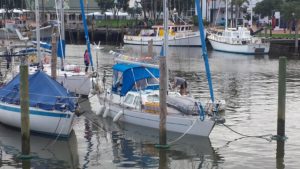
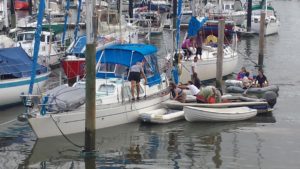
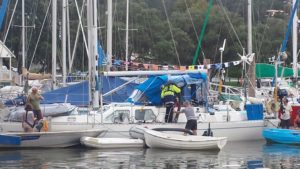
Three overalled and helmeted firemen were brought out to Zoonie in a tiny inflatable tender along with their pump (just imagine the sight of that) which took them a few minutes to start, but once in operation it made short work of returning the river water to the place from whence it had come. Merv had located the bilge outlet closure lever in the aft heads cupboard and once that was closed the water stopped pouring in and Zoonie’s flooding was over. “Ok with you if we tow her to the main pontoon outside the office, Rob, that way we can keep an eye on her and she is easy to access if necessary.”
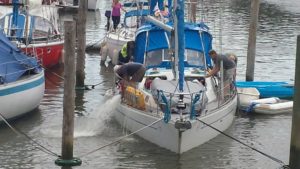
As I type this Zoonie is still in that exact same position. Of course this activity late on a Sunday afternoon had attracted a fair crowd on the shore and over the canopy bridge and amongst them were the good folk who had raised the alarm with a security officer. From being the Christmas ship covered in seasonal decorations, Zoonie had become the sinking yacht in Whangarei Marina that made the national and local news and newspapers. After the traumatic devastation caused by Cyclone Debbie, of which this incident was a part, the media needed a happy ending story of human altruism and Zoonie was the catalyst.
The alarm was also raised by the savvy cruising youngsters who could recognise a yacht in trouble at a thousand paces. They raced back to their mom on Enough and Miriam also raised the alarm. Once Sharron and Brian from the marina were aboard one rescuer said “Should we break in?” To which Sharron replied in a fraction of an instant,
“Yes” and our gas cylinder was grabbed for the purpose and used to instant effect.
We felt pretty helpless where we were so we drove to the ferry terminal to see if we could catch an earlier ferry than the one we had booked five days before that was to leave at 11.00am the next day, Monday. “Well it leaves in 45 minutes and that won’t give you enough time to get back to Spring Creek and return here before it sails.” The sympathetic lady reasoned. So ironically we would be on the same ferry we had already booked but would head straight back to Zoonie rather than spend the planned few days around the Hawkes Bay area.
Next morning in camp we had time to chat over her garden fence with the lady manager of the camp as she planted her spring seedlings and tell her our news while her lovely young dog enjoyed a comforting cuddle, comforting for all of us under the circumstances.
We then fed Eddy the eel with some squeezed bread balls, that way they sink and the greedy ducks can’t get them before driving with heavy hearts to the ferry.
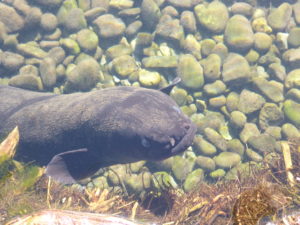
Since our arrival in NZ we had worked hard on the many jobs to be done on Zoonie and when we left on our camping trip she was in a state of near readiness for the new season back in the tropics. Now we had to face the repair work and all the time consuming delays, waiting for parts, waiting for the work to be done, the inevitable errors and re-doing of work and that’s only if our insurance company will play ball and accept our claim. Still we’d worry about that later. Take everything a step at a time. The first step being the small matter of the ten hour drive back to Whangarei.
While sitting on the ferry with two German Lads we told our sad story to them. Then one of them turned his coffee cup around to show an advertisement for the Top 10 Holiday Park Company which read, “Something to float everyone’s boat!” That made us all laugh.
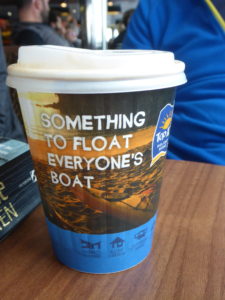
I think the adrenalin had started coursing through our systems because the drive back was easy. While it was still light we did have a good view of Mt Ruapehu. It was dark by half six and we each did around five hours driving during which time the roads were almost empty for the 860kms except for two houses that were on the move. It’s a big thing in NZ, to visit a house show area, all up high on wooden stilts ready to be loaded, chose the home of one’s dreams and have it delivered to the prepared site. A bit like Zoonie, raised, moved and (re) connected.
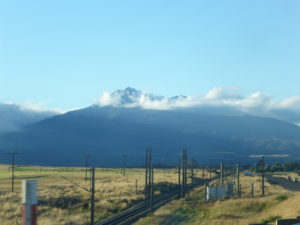
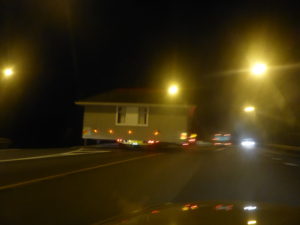
NZ The Calm after The Storm
“I can’t see her!” Naylene could not have known the weight of those words when we called her up as we drove home. No one had told Naylene of the incident that almost caused Zoonie to sit on the river bed beneath her berth, still tied to four piles. She did not know that Zoonie was moored just outside the window where she works. On further inspection she confirmed Zoonie was safely moored nearby.
Later we called our electrician, Scott and asked him to check Zoonie and while on board he opened the bilge pump outlet valve and heard the pump start once more. He was talking by phone to us at the time, while we were still on the road. “Ah did you hear that, the bilge pump just kicked in once, that’s good, means that’s still working then, oh shit she’s taking in water again, its bubbling up…..” He re-closed the bilge pump fitting once more, just as the rescuers had done for the first time since we have owned her and that gave us our first clue to the problem.
Sitting in Vicky on our way north we were sufficiently detached from the scene we could think objectively and being dedicated wine and beer brewers we were thinking along the possible reverse syphon effect and how this might be what had happened.
We arrived home just after 1.00am to a Zoonie who looked her usual self with nothing apart from the grubby marks of hard toil in the cockpit and a melted cockpit speaker to show for her ordeal. Down below all was clean and tidy, the windows were slightly damp on the inside but the upholstery was all dry including the mattresses in the fore peak where the bow had dipped lower than the rest of the hull. They are fixed higher than the settee berths in the saloon and that was how they had escaped.
With the car unloaded and parked we climbed into bed and grabbed a few hours sleep before the massive task ahead of us began. Instead of being almost ready to depart for the tropics once our family visit was over we now faced months of investigation and repair and an extended stay in NZ which would necessitate a visa extension for us both. Zoonie could be in NZ for two years before we would have to pay import tax on her as she is British, and NZ still likes us just a little bit, even though we joined the EU!
Our first few days back were busy with folk calling by Zoonie on their way along the pontoon to their boats, or making special visits, to explain their version of the events and their role in the rescue. It seemed that there were between nine and twelve people on board during the crucial two hour bail out. Questions started to arise in my mind like did this happen to any other boat, why did it not happen in Vavau when we had a day of heavy rain, or why has it never happened before since she was built in 1989? Did the bilge pump fail or was it overwhelmed by the back syphon?
I started asking questions and I needed to find out things like the wind direction at the time, was it down or up river? Gradually over the next few days the chain of events unfolded with the help of witness accounts and meteorological facts.
Cyclones rarely track this far south, or over NZ, that is why yachts come south to get away from them from November to April and insurance companies reward us for doing so. I knew already that the late season cyclones and hurricanes (the latter the same thing but in the northern hemisphere) are the worst and most powerful and are worth avoiding.
Two fellow cruisers, a German couple we met in Marsden Cove when we arrived back in Nov last year, set off just before Cyclone Debbie made it’s way towards NZ to get to India for July and meet up with friends. They left really early, usually May is the earliest and some NZ sailors wait until as late as possible as the cyclone season is getting later every year. Their sturdy boat was sent into an eskimo roll by the raging sea and they were dismasted. Both survived and they were motoring to New Caledonia when they made their report. The only deadline sailors should bow to are weather ones but the weather this year is unpredictable and is not fitting in with historic patterns.
The window of opportunity between the end of the cyclone season and the beginning of the storm season here, when winter storms race up and over NZ from the southern ocean and into the Tasman Sea, is getting shorter. Also the time periods for the gap between low pressure systems is around two to three days instead of a week as we found on our way down.
Sailing cruisers need 48 hours minimum to get clear of NZ on route north to clear bad weather and that is barely happening this year. Each day now we see yachts leaving. Our diaspora of cruisers is also sending some, like us, off to explore by land, and others are setting themselves up house minding in the area to give them more living space for a few months. The remainder are spending some time back in their own countries, leaving their boats under watchful eyes here.
The insurance company claim form had a three inch area of space in which we could file our version of events. So I simply wrote, ‘see attached report’ and proceeded to complete 3 pages.
The prevailing wind direction here is SW, rather like in the UK, and the hills around Whangarei often ward off the bad weather and protect the town and marina. Michelle said she would ask her husband Alex if he would confirm the wind and thus rain direction over the days leading up to Zoonie’s flooding.
An extreme amount of rain and a lot of wind had hit the area as Debbie passed, all of it coming up river. Zoonie faced up river and was pinned in position, unable to swing to the wind as she had on her mooring ball in Vavau. So instead of the rain hitting the front of the mast and travelling down to the deck and harmlessly over the sides, a constant trickle ran down inside the mast into her bilge where it triggered the bilge pump.
The pump worked constantly on and off and a column of water was formed from the trickling rain supply, through the pump and up the pipe, over the swan neck that reaches the side deck inside, well above the outside water level and down to the hull outlet. This is below water level as they are often designed to be so they cannot be seen. The Dutch apparently always have them just above the waterline so there is always air in them to prevent any syphon effect.
One would have thought the height of the swan neck would be sufficient to break a solid column of water just by gravitational pull, but no it wasn’t. A solid column of water started to flow from the river into Zoonie’s bilge later joined by more through the sink from where the plug hole drain enters the cockpit drain.
If this had happened at night Zoonie would have sunk and I prefer not to follow this line of thought as it was there by the act of kind people we did not go.
So why did this not happen to other boats, well actually it did, but not sufficiently to cause a flooding. I know that Miriam on Enough, whose two sons were amongst those who raised the alarm, spent some time wringing out the towel that was shoved into their mast-well. Like us they faced up river and have a keel mounted mast. We were not on Zoonie at the time to oversee preventive measures. Also many other yachts have deck mounted masts with no hole through the deck to the keel so rainwater flows harmlessly overboard.
Fortunately the insurance company accepted the claim as caused by Extreme Weather, they had already seen the national newspaper report showing a picture of Zoonie’s rescue. So we could get on with gathering together estimates for the repair work.
The next three weeks before the arrival of Gary and Emily, Henry and Ruby and close friend Lauren on their long planned holiday with us we had our work cut out playing a tennis game of responding to emails from numerous sources then pinging ‘the ball’ back into their court as quickly as possible.
Rob acted with his usual sense of immediacy and within a couple of days of being back on board Zoonie had breathers on all her swan necks, shut off valves on all pipes and non-return valves where they hadn’t already been fitted. Seemed strange to have to make a hole and cut a pipe to prevent a leak.
Gerry was our insurance assessor and after a lot of investigation and thought based on the evidence and his existing knowledge and experience we came to the same conclusions as to the cause and when I asked him to look at my report and tell me what he thought of it he simply wrote, “I wouldn’t change a thing’.
Happy Hour at the Love Mussel on the Quay provided a bit of light relief when many of us visiting cruisers meet for half price drinks and we had numerous dinner parties on board for our new friends who had helped in Zoonie’s rescue and for other pals who were leaving soon on their yachts and heading north. Wayne and Barry have to start work back in the UK in June 2018, so they have their work cut out in Naughty Boy. Kyle and Shelley in Bubbles cannot wait to get to Fiji and start helping school children with supplies. Judging by the position on their blog they could well be there already.
We have always felt the need to be flexible in planning our cruising and that belief is certainly getting practice now. Our friends Gail and Tony are staying put with some big jobs to do on Cetacea and numerous others are here until next year. A prolonged stay means we can also take advantage of cheaper flights home between August and October and we are free to explore this lovely country some more next Jan and Feb.
Every Cloud has a Silver Lining
Just before our family arrived we underwent our medicals, chest xrays and blood tests required for the extension to our visas. They revealed that Rob has a leaking heart valve, which is not serious and apparently most members of the population have to some degree, but we can check it out when we come home. Also, having had the medicals is no bad thing anyway.
Between Cyclone Debbie and the arrival of Cyclone Cook there was plenty more rain drenching the already saturated land. The Coromandel Peninsula was closed and hundreds of people had to flee their homes to escape the rising water. We know this is the buffer year between El Nino and La Nina and uncharacteristic weather is to be expected and poor NZ is certainly getting more than its fair share.
How would it affect us as we camped through the central North Island with our family we wondered? We were about to find out.
